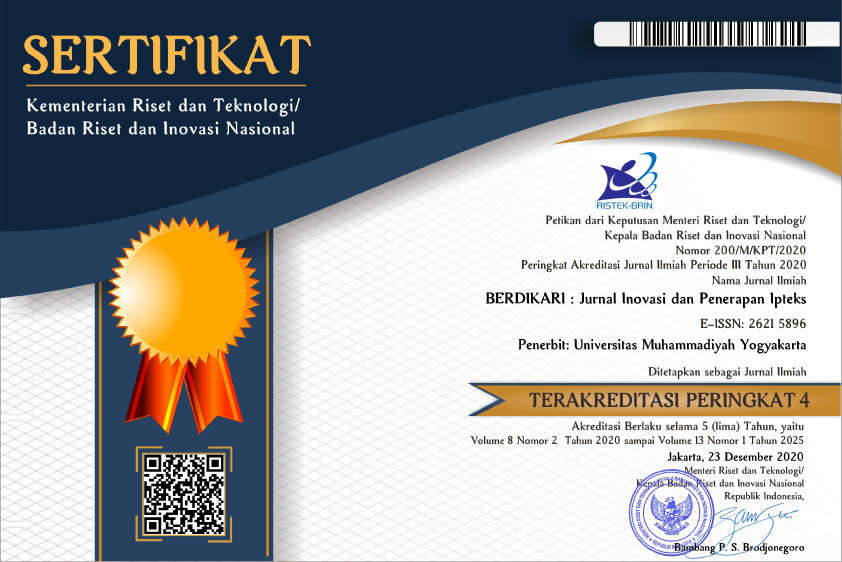Pemanfaatan Bahan Bekas sebagai Alat Peraga IPA Ramah Lingkungan
Abstract
Keywords
Full Text:
PDFReferences
Ashfaque-E-Alam, Md., Islam, Md.R. and Faria, I.J. (2017) ‘Development and validation of a low-cost visible light spectrophotometer’, in 2017 4th International Conference on Advances in Electrical Engineering (ICAEE). 2017 4th International Conference on Advances in Electrical Engineering (ICAEE), pp. 653–657. Available at: https://doi.org/10.1109/ICAEE.2017.8255437.
Avsar Erumit, B., Akerson, V.L. and Buck, G.A. (2021) ‘Multiculturalism in higher education: experiences of international teaching assistants and their students in science and math classrooms’, Cultural Studies of Science Education, 16(1), pp. 251–278. Available at: https://doi.org/10.1007/s11422-020-09996-2.
Childers, G. and Elz, H. (2022) ‘Unveiling the scientists and engineers in the Southern Appalachian community’, Cultural Studies of Science Education, 17(4), pp. 1141–1158. Available at: https://doi.org/10.1007/s11422-022-10133-4.
Choudhury, M.A. (2016) ‘Introduction: Foundations of the Qur’anic Worldview’, in M.A. Choudhury (ed.) Absolute Reality in the Qur’an. New York: Palgrave Macmillan US (Palgrave Series in Islamic Theology, Law, and History), pp. 3–18. Available at: https://doi.org/10.1057/978-1-137-58947-7_1.
Diana, R., Surahman, E. and Makiyah, Y.S. (2022) ‘The Effect of Problem Based Learning with Laboratory Activities on Students’ Problem-Solving Skills’, Jurnal Pendidikan MIPA, 23(3), pp. 1017–1029.
Diraya, I., Budiyono, A. and Triastutik, M. (2021) ‘Kontribusi Virtual Lab Phet Simulation untuk Membantu Praktikum Fisika Dasar’, Phenomenon : Jurnal Pendidikan MIPA, 11(1), pp. 45–56. Available at: https://doi.org/10.21580/phen.2021.11.1.7367.
Herlina, K. et al. (2022) ‘Development of a Simple and Low-Cost Light Diffraction Props for Teaching and Learning Optics during Covid-19 Outbreak’, Jurnal Pendidikan MIPA, 23(2), pp. 437–447.
Hidayati, I.W. and Usman, N. (2020) ‘Peningkatan Minat Baca Masyarakat Melalui Wisata Leterasi’, Berdikari: Jurnal Inovasi dan Penerapan Ipteks, 8(1), pp. 59–64. Available at: https://doi.org/10.18196/bdr.8177.
Jannah, R. et al. (2022) ‘Effect Size : STEM pada Pembelajaran IPA Terhadap Keterampilan Abad 21’, Natural Science: Jurnal Penelitian Bidang IPA dan Pendidikan IPA, 8(2), pp. 79–88. Available at: https://doi.org/10.15548/nsc.v8i2.4227.
Junaeti, E. et al. (2022) ‘Using Rule-based Procedural Content Generation to Generate Students Cognitive and Affective Ability in Game Teaching’, Jurnal Pengajaran MIPA, 27(1). Available at: https://doi.org/10.18269/jpmipa.v27i1.52943.
Nichols Hess, A.K. and Greer, K. (2016) ‘Designing for Engagement: Using the ADDIE Model to Integrate High-Impact Practices into an Online Information Literacy Course’, Communications in Information Literacy, 10(2), pp. 264–282.
Putri, V.L. and Wahyudi, I. (2022) ‘PENGARUH PRAKTIKUM MENGGUNAKAN PHYSICS TOOLBOX SENSOR SUITE BERBASIS INKUIRI TERBIMBING TERHADAP KEMAMPUAN INTERPRETASI GRAFIK SISWA’, Jurnal Inovasi dan Pembelajaran Fisika, 9(2), pp. 108–120. Available at: https://doi.org/10.36706/jipf.v9i2.18715.
Rahmadani, W. and Hurriyah, H. (2019) ‘Model Pembelajaran Cooperative Script dalam Mendorong Aktivitas Belajar IPA-Fisika’, Natural Science: Jurnal Penelitian Bidang IPA dan Pendidikan IPA, 5(2), pp. 897–906. Available at: https://doi.org/10.15548/nsc.v5i2.1092.
Roslina, R., Samsudin, A. and Liliawati, W. (2022) ‘Effectiveness of Project Based Learning Integrated STEM in Physics Education (STEM-PJBL): Systematic Literature Review (SLR)’, Phenomenon : Jurnal Pendidikan MIPA, 12(1), pp. 120–139. Available at: https://doi.org/10.21580/phen.2022.12.1.11722.
Sands, D. (2021) ‘Physics Education Research and the Foundations of Physics: A Case Study from Thermodynamics and Statistical Mechanics’, in B.G. Sidharth et al. (eds) Fundamental Physics and Physics Education Research. Cham: Springer International Publishing, pp. 117–126. Available at: https://doi.org/10.1007/978-3-030-52923-9_11.
Seiler, E. and Stamatescu, I.-O. (2007) ‘Introduction – The Many-Fold Way of Contemporary High Energy Theoretical Physics’, in Ion-Olimpiu Stamatescu and Erhard Seiler (eds) Approaches to Fundamental Physics: An Assessment of Current Theoretical Ideas. Berlin, Heidelberg: Springer (Lecture Notes in Physics), pp. 3–18. Available at: https://doi.org/10.1007/978-3-540-71117-9_1.
Sugiyono, S. (2010) Metode Penelitian Kuantitatif dan Kualitatif dan R&D. ALFABETA Bandung. Available at: https://www.pdfdrive.com/prof-dr-sugiyono-metode-penelitian-kuantitatif-kualitatif-dan-rd-intro-e56379944.html (Accessed: 11 January 2023).
Syafii, M.L., Kusnawan, W. and Syukroni, A. (2020) ‘Penumbuhkembangan Motivasi Guru Madrasah Tsanawiyah Mambaul Ulum Perdana dalam Peningkatan Kualitas Pendidikan’, Berdikari: Jurnal Inovasi dan Penerapan Ipteks, 8(2), pp. 92–103. Available at: https://doi.org/10.18196/bdr.8281.
Tina, A., Saehana, S. and Wahyono, U. (2021) ‘PENGEMBANGAN MEDIA ALAT PRAKTIKUM PELAYANGAN GELOMBANG BERBASIS MIKROKONTROLER ARDUINO UNO’, Jurnal Inovasi dan Pembelajaran Fisika, 8(2), pp. 168–183. Available at: https://doi.org/10.36706/jipf.v8i2.14420.
Triani, F., Asrizal, A. and Usmeldi, U. (2022) ‘META ANALISIS PENGARUH PENERAPAN STEM TERHADAP HASIL BELAJAR FISIKA PESERTA DIDIK’, Jurnal Inovasi dan Pembelajaran Fisika, 9(1), pp. 99–107. Available at: https://doi.org/10.36706/jipf.v9i1.16507.
Wahyuni, A., K, C.C. and Syukri, M. (2018) ‘INTERCONNECTION BETWEEN STUDENT’S PREREQUISITE COURSES ACHIEVEMENT AND SUBSEQUENT ACHIEVEMENT IN MECHANICS’, Jurnal Pengajaran MIPA, 23(2), pp. 107–111. Available at: https://doi.org/10.18269/jpmipa.v23i2.15074.
Widodo, N. and Nugroho, S. (2019) ‘Peningkatan Pemahaman Kurikulum 2013 bagi Guru Sekolah Dasar’, Berdikari: Jurnal Inovasi dan Penerapan Ipteks, 7(2), pp. 171–186. Available at: https://doi.org/10.18196/bdr.7270.
Widyastuti, T. and Astuti, R.J. (2016) ‘Penataan Halaman Sekolah Sebagai Ekoedukasi’, Berdikari: Jurnal Inovasi dan Penerapan Ipteks, 4(1), pp. 54–62. Available at: https://doi.org/10.18196/bdr.416.
Zainuddin, Z. et al. (2022) ‘Implementation of Engineering Everywhere in Physics LKPD Based on STEM Approach to Improve Science Process Skills’, Jurnal Pendidikan Sains Indonesia (Indonesian Journal of Science Education), 10(2), pp. 231–239. Available at: https://doi.org/10.24815/jpsi.v10i2.23130.
DOI: https://doi.org/10.18196/berdikari.v11i2.17845
Refbacks
- There are currently no refbacks.

This work is licensed under a Creative Commons Attribution 4.0 International License.
__________________________________________________________________
Contact us: BERDIKARI : Jurnal Inovasi dan Penerapan Ipteks, Address: Gedung D, LP3M UMY, Alamat: Jl. Brawijaya, Tamantirto, Kec. Kasihan, Bantul, Daerah Istimewa Yogyakarta 55183. Email: berdikari@umy.ac.id

Ciptaan disebarluaskan di bawah Lisensi Creative Commons Atribusi 4.0 Internasional.



